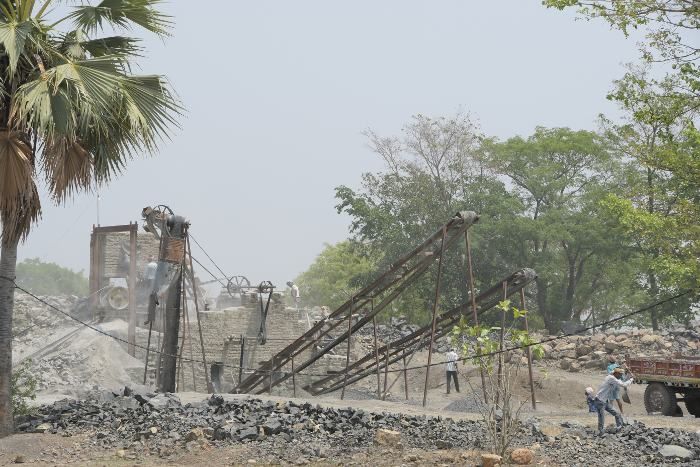“What’s the point of development when our kids are going to die because of pollution?”
For development projects, like the construction of metros or bullet trains, authorities cut trees and then promise to compensate by planting saplings as many as three or four times for every tree cut. But how many of these saplings actually survive? The reality is hard to digest


In September 1730, 363 people sacrificed their lives to protect trees. Popularly known as Khejarli massacre, the incident took place 26 kms from Jodhpur in Rajasthan. The then Maharajah of Jodhpur, Abhay Singh, asked his minister to bring firewood, required to cook slaked lime for whitewashing his newly-built palace. In order to protect trees, Amrita Devi Bishnoi, a local woman, along with villagers, staged a protest. Amrita Singh, her three daughters, and more than 300 villagers were killed.
Read more about Khejarli massacre here
Earlier this month, hundreds of Mumbaikars, including young children, came together for a cause – to protest against the proposed cutting of 2,702 trees at Aarey for the car shed of Metro 3. They braved the rain, shouted slogans and formed a human chain.
While both the incidents took place centuries apart, the narrative was common — to save trees. There have been instances where thousands of trees were cut in the name of development. The metros, monorails or the bullet trains have come at a price. We asked citizens and authorities to comment on how to strike a balance between development and saving the environment.
At a conference held at Greater Noida in Uttar Pradesh recently, Prime Minister Narendra Modi announced to combat desertification by restoring 26 million hectares of land by 2030. At the same time, just 50 kms from here, in Gurgaon, the BJP government in Haryana opened up 33% of the forest area in the Aravallis for real estate. The city will lose nearly 60,000 acres of forest cover, which is 50% of the Aravallis.
“Earlier, Gurgaon and Faridabad were jungles, but with it becoming an IT hub, many people moved here. Both these cities were developed at the cost of forests. Since areas in Aravallis are mostly rocky, the land is being used illegally for mining,” said Shobhit Agarwal, 28, a local resident of Faridabad, Haryana.
“Gurgaon is no more a jungle of trees. It is a concrete jungle. We don’t see trees here. All we get to see is development,” said Poonam Bhargava, 54, who lives In Janakpuri in South West Delhi.

The ground reality
For the development projects, authorities cut trees and then promise to compensate by planting saplings as many as three or four times for every tree cut. But the ground reality is quite different. Survival of saplings is a major concern. Due to lack of care, saplings die even before compensating for the trees lost. “Even if they plant 3,000 trees for cutting 1,000 trees, only 30-40% saplings survive.
Survival should be 90% and above, but the ground reality is the other way around,” said Dr Pradeep Tripathi, founder of Green Yatra, an NGO that works for the environment.
Recently, the Uttar Pradesh government set the world record by planting 22 crore saplings on a single day in Lucknow. But the experts question its utility. “When you are planting trees to make a world record, you are not planting trees, you are just making records. The Yogi government planted so many trees, but how many of them survived?” asked Tripathi, who is also known as the man who is creating Mumbai’s first urban forest.
“Green highways are only the paper; I see no such in reality. Plus, there’s no use of plantation if saplings don’t survive. When the temperature goes up to 45 degrees, who looks after these saplings?” asked Dr Tripathi adding: “During Shivraj Singh Chauhan’s government, nearly 6.5 crore trees were planted. But two years ago, it was revealed in news that the sapling which the CM had planted didn’t survive. In fact, the survival was not even 10%, which means out of 6.6 crore trees, nearly 6 crore saplings died.”
Citizens should be made aware
Poonam Bhargava believed that the government planting 2-3 tress is not going to help unless we, citizens, are aware of the ill-effects of cutting trees.
When as spoke to an officer working with the Lucknow Metro Rail Corporation, he said on the condition of anonymity: “Any development project is beneficial to the environment in the long run.”
“We planted at least 10 trees in lieu of every tree cut. 90% of them survived. Out of 2,300 trees we touched upon only 1,100. Out of these, we relocated 470 trees. We had to cut some 600 trees as all of them couldn’t be transplanted,” he added.

According to the LMRC, of the total trees identified for the Lucknow metro project, 880 trees were cut, 410 were relocated and 537 were saved.
The LMRC officer said that as far as the environment is concerned, the LMRC had planted 10,000 trees as compensation for every tree cut for the metro project. “Initially, we took permission to touch upon 2,300 trees, but we made some changes in the planning — like we changed the alignment of the rail map and altered the breadth and position of the staircase.”
When the reporter asked the LMRC officer if the development projects are a threat to the environment, he said, “Definitely Not!” He added: “Four years back, when there was no metro in Lucknow, the pollution level was increasing exponentially, but after the construction of the metro, pollution level has decreased by six times. On an average 65,000 people are commuting using metro that means the same number will go off-road.”
“Infrastructure development is killing nature
“Nearly 25 lakh people die every year due to air pollution. And that’s a big number. Of what use is this development then when your two-year-old kid may die because of it it?” asked Dr Pradeep Tripathi.
Delhi’s green cover has been depleting fast over the years due to rampant tree felling. Over one lakh trees were cut during 2006-2014 for metro and other development projects, which reduced the city’s forest cover to 10% from the optimum level of 33%, a Delhi high court appointed amicus informed the court.
A total of 53, 467 mangrove trees in Maharashtra and Gujarat are to be removed to make way for the bullet train project. The project involves a total forest area of 137.149 hectares, including 24.137 hectares mangrove forest area.
On August 29, the Brihanmumbai Municipal Corporation’s (BMC) Tree Authority granted an approval to cut as many as 2,700 trees for the Metro car shed in Aarey in Mumbai.
However, on September 17, the Bombay High Court said that Mumbai Metro Rail Corporation Ltd (MMRCL) should not cut trees in Aarey for a Metro car shed till September 30.
When Rural Connection asked Tripathiof the possibilities of saving 2,700 Aarey trees, he said: “There are seven-eight other options available in Mumbai besides Aarey. Authorities say the other options will cost them nearly Rs 750 crore. Aarey is the cheapest one, plus it is the government’s property, so it will save them a huge sum.”
Countering this, the LMRC officer, who was based in Mumbai for several years, said: “There’s no substitute for the car shed construction in Mumbai. Talking about Aarey, it shrinks every year. But nobody talks about that. Mumbai is unlike Delhi and Lucknow, its geographical area is more like a long patch of land. It cannot expand laterally like other cities.”

So, what can be done?
“As for now, contractors, who are not passionate about planting the trees, plant trees. They just do it for the sake of doing work. The government should give the onus of plantation to the passionate NGOs and the locals,” said Tripathi whose NGO is planning to plant 10 crore trees across India by 2025. They have planted 5 lakh trees so far. The NGO aspires to grow the urban dense forests across Mumbai and Maharashtra.
Tripathi told RuralConnection about a Japanese method –Miyawaki — that can create dense forests in cities within a short span. He said, “With the help of Miyawaki, a two feet long sapling can grow into a 20 feet long tree within two years. Normally in a one-acre land, not more than 1000 trees could be planted, but with this method, we can plant 12,000 trees, with three trees in a land of one square meter. After two years it becomes maintenance-free.”
“Authorities can help it grow near toll roads, petrol pumps, highways and food courts; there they can grow them in one-acre land. They should use this innovative method and form cluster forests,” added Tripathi, “When the project to construct highways passes people then should start compensating for trees loss, so that when after the completion of the project, those trees will be big enough to compensate for the loss.”
Talking about the Miyawaki technique, the LMRC officer said: “Big vehicles need a certain turning radius. Say, if you are putting the cement on a space, you don’t stand on that particular spot and then pour the cement, you need to stand on a boundary. Similarly, we can’t first plant trees and then proceed with the construction work.”

